Kochi Japan Tourism is a hidden gem offering stunning natural landscapes, rich culture, and delicious cuisine. SIXT.VN is here to help you discover the best of Kochi, from its historic castle to its pristine rivers. Ready to explore a unique side of Japan? Let’s uncover the attractions in Kochi Prefecture!
1. What Makes Kochi, Japan a Unique Tourist Destination?
Kochi stands out because of its untouched natural beauty and vibrant local culture. Unlike the crowded tourist hotspots, Kochi offers an authentic Japanese experience with its clear rivers, long coastlines, and friendly locals.
Kochi Prefecture, located on the island of Shikoku, is renowned for its warm climate, stunning waters, and unique blend of attractions. According to the Japan National Tourism Organization (JNTO), Kochi’s appeal lies in its ability to offer visitors a serene escape from the hustle and bustle of Japan’s larger cities. This region boasts an abundance of sunshine, contributing to lush landscapes and crystal-clear rivers, such as the Niyodo River, known for its “Niyodo Blue” waters, and the Shimanto River, celebrated as one of Japan’s last unobstructed streams.
What sets Kochi apart is not just its natural beauty but also its rich cultural heritage, which is deeply embedded in the local markets, activities, and cuisine. The Sunday Market in Kochi City, for instance, has thrived for over 300 years, offering visitors a glimpse into the region’s traditional foods and crafts. The Hirome Market serves as a social hub where locals and tourists mingle, sampling an array of local and international flavors. Kochi is also famous for its Yosakoi Festival, a vibrant celebration that attracts dance groups from across the country, showcasing the region’s energetic spirit and colorful costumes. This combination of unspoiled nature and cultural richness makes Kochi a unique and attractive destination for travelers seeking an authentic and immersive Japanese experience.
2. What Are the Top City Destinations in Kochi City?
Kochi City offers a blend of history, culture, and local charm, making it an ideal base for exploring the prefecture. Don’t miss Kochi Castle, Sunday Market, Hirome Ichiba, Makino Botanical Garden, and Chikurin Temple.
2.1. Why Should I Visit Kochi Castle?
Kochi Castle is Japan’s only castle where all original structures have been preserved, making it a must-see for history enthusiasts. The keep offers stunning views of the city.
 Kochi Castle stands high atop the downtime area of Kochi City, surrounded by fifteen castle structures, beautiful parks, and a picturesque moat
Kochi Castle stands high atop the downtime area of Kochi City, surrounded by fifteen castle structures, beautiful parks, and a picturesque moat
Kochi Castle, known locally as Kōchi-jō, is more than just a historical landmark; it’s a symbol of resilience and architectural ingenuity. Originally constructed in 1603, the castle was unfortunately consumed by a fire in 1727. However, it was meticulously rebuilt by 1749, retaining its original design and materials, which is a rare feat in Japanese castle architecture. This careful reconstruction has earned Kochi Castle the distinction of being the only castle in Japan where all original structures have been preserved.
According to the Japanese government’s Agency for Cultural Affairs, Kochi Castle is designated as an Important Cultural Property, underscoring its significance in the nation’s historical and cultural narrative. Visitors can explore the castle’s keep, which is one of only twelve original castle keeps still standing in Japan. Inside, the Kochi Castle Museum offers insights into the castle’s history and the local feudal lords who once resided there.
Beyond its historical value, Kochi Castle offers breathtaking panoramic views of Kochi City from its keep observatory. The surrounding parkland and moat add to the castle’s picturesque setting, making it an excellent first stop for visitors to appreciate the city’s layout and scenic beauty. Its central location also makes it a convenient starting point for exploring other nearby attractions, such as the vibrant Sunday Market. Visiting Kochi Castle not only provides a deep dive into Japanese history but also a stunning visual experience that captures the essence of Kochi’s charm.
2.1.1. What Are the Opening Hours of Kochi Castle?
Kochi Castle is open from 9:00 to 17:00 daily. This allows visitors ample time to explore the castle grounds and museum.
2.1.2. How Much Does It Cost to Enter Kochi Castle?
The entrance fee to explore the insides of the keep and Kochi Castle Museum is less than 500 yen, making it an affordable attraction for all tourists.
2.2. What Can I Find at the Sunday Market in Kochi?
The Sunday Market is a vibrant open-air market that has been running for over 300 years. You can find a variety of local foods, unique fruits, vegetables, cutlery, and traditional crafts.
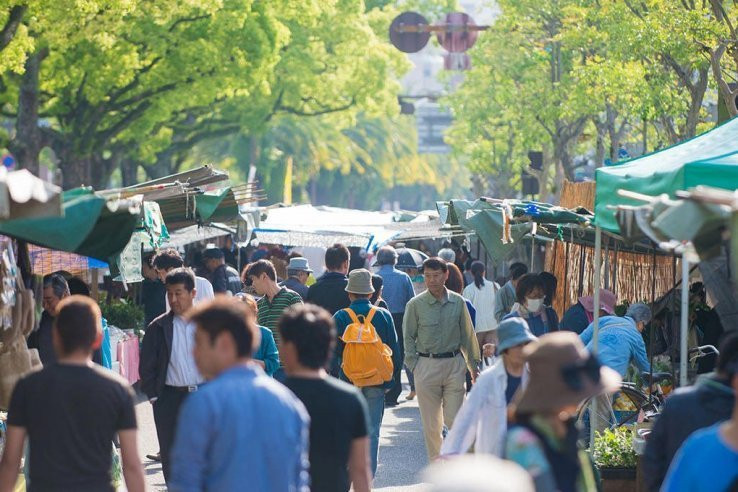 The Sunday Market is an open-air market along the downtown streets of Kochi that has continued for more than 300 years since the Edo period
The Sunday Market is an open-air market along the downtown streets of Kochi that has continued for more than 300 years since the Edo period
The Sunday Market in Kochi, known locally as “Nichiyoichi,” is more than just a place to buy local goods; it’s a vibrant cultural institution that has thrived for over three centuries. Originating in the Edo period, this open-air market stretches along the downtown streets of Kochi City, offering a unique glimpse into the region’s traditions and community spirit. According to the Kochi Prefectural Government, the market features approximately 500 stalls every Sunday, making it one of the largest and oldest continuously running markets in Japan.
Visitors to the Sunday Market can immerse themselves in the lively atmosphere, watching vendors and customers interact in the distinctive Kochi dialect. The market is renowned for its wide array of local foods and products, including unique fruits and vegetables, handmade cutlery, and traditional crafts. This is an excellent opportunity to sample local delicacies like Imokenpi (candied sweet potato sticks) and Botamochi (sweet rice balls), which are regional specialties.
Beyond the shopping experience, the Sunday Market is a social event. Locals come to meet, chat, and enjoy the day, making it a perfect place for tourists to engage with the community and experience Kochi’s warm hospitality. The market’s central location, extending from the Otemon main gate of Kochi Castle for over one kilometer, makes it easily accessible and a natural extension of a visit to the castle. Exploring the Sunday Market provides not only a chance to purchase unique souvenirs but also an immersive cultural experience that captures the heart of Kochi.
2.2.1. Where Is the Sunday Market Located?
The market extends from the Otemon main gate of Kochi Castle for over one kilometer, making it easily accessible after visiting the castle.
2.2.2. What Are the Business Hours of the Sunday Market?
The Sunday Market is open on Sundays from 5:00 to 18:00 (5:30 to 17:00 from October to March). Plan your visit accordingly to experience the market at its best.
2.3. Why Is Hirome Ichiba a Must-Visit?
Hirome Ichiba is a bustling market where locals and visitors gather to enjoy local and international cuisine. It features over 65 street stall-style restaurants and shops.
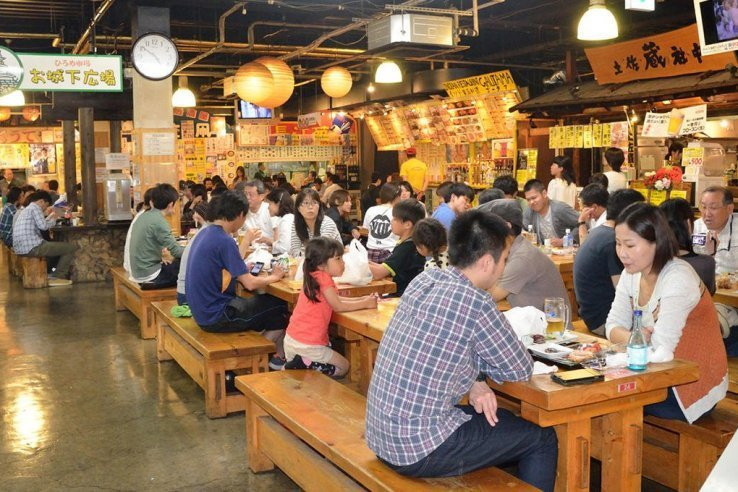 Hirome Market is the meeting hub for locals and visitors alike to share stories and sample local and international flavors
Hirome Market is the meeting hub for locals and visitors alike to share stories and sample local and international flavors
Hirome Ichiba, often referred to as Hirome Market, is a dynamic culinary and social hub in Kochi City, drawing both locals and tourists into its lively atmosphere. This bustling market houses over 65 street stall-style restaurants, fresh fish and meat shops, local alcohol vendors, unique souvenir shops, and clothing boutiques, creating a diverse and engaging experience. According to the Kochi City Tourism Association, Hirome Ichiba is designed to encourage interaction and the sharing of stories among visitors, making it a unique cultural experience.
One of the market’s distinctive features is its layout, with long tables spaced throughout, encouraging visitors to order takeout from multiple restaurants and sample a variety of foods. A must-try dish is the Katsuo no Tataki, or seared bonito tuna, prepared in a theatrical demonstration with large flames over straw pits. This dish is served sliced and seared with a touch of salt, offering a taste of Kochi’s culinary excellence.
Hirome Ichiba stands out for its open and communal environment, which is a contrast to the fast-paced dining culture of larger cities like Tokyo. In Kochi, locals are known for their fondness for drinking at all hours, adding to the market’s friendly and relaxed ambiance. Tourists will find it easy to strike up conversations and enjoy the company of locals, making Hirome Ichiba not just a place to eat, but a place to connect and experience the local culture. Its location next to Kochi Castle and along the same road as the Sunday Market makes it a convenient stop for those exploring the city.
2.3.1. What Type of Food Should I Try at Hirome Ichiba?
Katsuo no Tataki (seared bonito tuna) is a must-try. It’s prepared in a grand demonstration with large flames over straw pits, offering a unique culinary experience.
2.3.2. What Are the Opening Hours of Hirome Ichiba?
Hirome Ichiba is open from 10:00 to 21:30, providing ample time to enjoy the market’s offerings throughout the day and evening.
2.4. Why Visit the Kochi Prefectural Makino Botanical Garden?
The Makino Botanical Garden is one of the most comprehensive botanical gardens in Japan, featuring a vast collection of plants and beautiful walking paths.
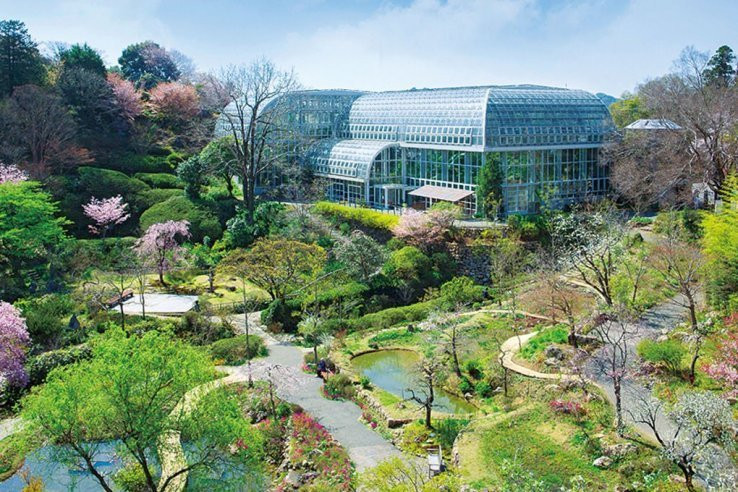 Nestled on Godaisan, a mountain just East of Kochi, The Kochi Prefectural Makino Botanical Garden is one of the most comprehensive botanical gardens in all of Japan
Nestled on Godaisan, a mountain just East of Kochi, The Kochi Prefectural Makino Botanical Garden is one of the most comprehensive botanical gardens in all of Japan
The Kochi Prefectural Makino Botanical Garden, nestled on Godaisan Mountain just east of Kochi City, is a premier botanical destination in Japan, celebrated for its extensive collection and serene environment. Created in honor of Dr. Tomitaro Makino (1862-1957), a world-renowned botanist, the garden spans a vast area and features an impressive variety of plant species. According to the garden’s official website, it houses over 3,000 types of tropical plants in its expansive greenhouse, making it a haven for botany enthusiasts and nature lovers alike.
Visitors can explore the outdoor garden’s winding paths, discovering seasonal plants and unique specimens, such as plants with leaves resembling goldfish, which can be purchased as souvenirs. The garden also includes museum halls and displays dedicated to Dr. Makino’s achievements and contributions to botanical garden development across Japan.
The Kochi Prefectural Makino Botanical Garden offers more than just a visual experience; it’s an educational journey into the world of botany. The museum provides in-depth information about Dr. Makino’s research and the importance of plant conservation. The serene atmosphere of the garden, combined with its scientific significance, makes it a must-visit destination for those seeking to connect with nature and learn about the botanical world. The garden’s location on Godaisan also allows visitors to easily combine their visit with other nearby attractions, such as Chikurin Temple, enhancing the overall experience.
2.4.1. How Do I Get to the Makino Botanical Garden?
You can take the My Yu Bus from JR Kochi Station (30 minutes) to the Makino Shokubutsuen Seimon Mae bus stop. This is a convenient and scenic route.
2.4.2. When Is the Makino Botanical Garden Closed?
The garden is closed from December 27 to January 1. Plan your visit outside these dates to avoid disappointment.
2.5. What Is Special About Chikurin Temple?
Chikurin Temple is an important stop on the Shikoku Pilgrimage and the most famous temple in Kochi Prefecture. It features a beautiful five-story pagoda and serene moss-covered gardens.
Chikurin-ji, also known as Chikurin Temple, stands as a significant spiritual and historical site on Godaisan Mountain, near the Makino Botanical Gardens in Kochi Prefecture. Established in 724 by the Buddhist priest Gyōki under the order of Emperor Shomu, Chikurin-ji is an essential stop on the Shikoku Pilgrimage, holding the 31st position among the 88 temples. According to the Shikoku Pilgrimage Temple Association, this temple is renowned for its serene atmosphere and historical importance, attracting pilgrims and tourists alike.
Visitors to Chikurin-ji can explore its peaceful outdoor area, which is filled with lush forests and tranquil, moss-covered gardens. The main temple complex includes several notable buildings, with the colorful five-story pagoda being a prominent feature. The temple’s architecture and surrounding landscape offer a glimpse into traditional Japanese Buddhist culture.
Chikurin-ji offers a unique blend of spiritual and aesthetic experiences. Its serene gardens provide a calming environment for reflection, while the temple buildings showcase exquisite traditional design. Being part of the Shikoku Pilgrimage, it also holds a special significance for those interested in Buddhist practices and history. Its proximity to other attractions on Godaisan, such as the Makino Botanical Gardens and the Godaisan observatory, makes it an ideal destination for a comprehensive exploration of the area.
2.5.1. How Can I Get to Chikurin Temple?
Take the My Yu Bus from JR Kochi Station (30 minutes) to the Chikurin-ji bus stop. The bus ride offers scenic views of the surrounding area.
2.5.2. What Is the Best Time to Visit Chikurin Temple?
The temple is open access, but the last bus towards Kochi Station departs around 17:30. Plan your visit to allow ample time to explore and catch the bus back.
3. What Are Some Must-See Country Destinations in Kochi Prefecture?
Venture beyond Kochi City to discover natural wonders like Katsurahama Beach, Niyodo River, Shimanto River, Shikoku Karst Natural Park, and Cape Ashizuri. Renting a car or camper van is recommended for exploring these destinations freely.
3.1. Why Is Katsurahama Beach a Popular Destination?
Katsurahama Beach is famous for its picturesque landscape, featuring a great concave arc with a cliff, a small Japanese Shrine (Ryuogu Shrine), and a dense pine grove behind the sands.
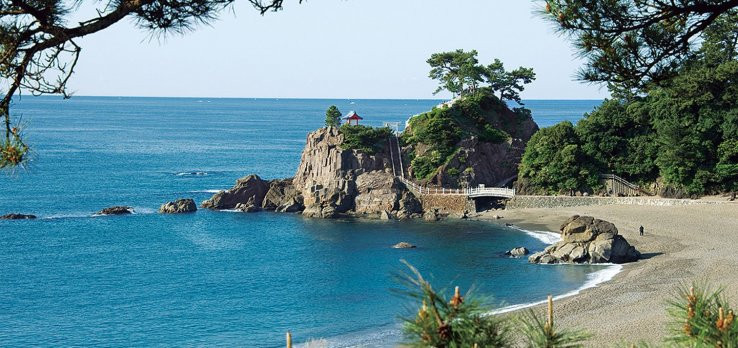 Katsurahama is essentially a Kochi City destination as it is the last stop on the aforementioned My Yu Bus route
Katsurahama is essentially a Kochi City destination as it is the last stop on the aforementioned My Yu Bus route
Katsurahama Beach, located just a short bus ride from Kochi City, is renowned for its scenic beauty and historical significance. This stunning beach has been a popular destination since ancient times, celebrated for its picturesque landscape and cultural associations. According to the Kochi Visitors & Convention Association, Katsurahama is particularly famous as a venue for viewing the moon, adding to its romantic allure.
The beach itself stretches in a graceful concave arc, framed by a dramatic cliff and the Ryuogu Shrine at one end, accessible via a walking path. What sets Katsurahama apart is the dense, traditional Japanese green pine grove that lines the beach, creating a striking contrast with the azure ocean. This unique combination of elements makes Katsurahama a favorite subject for photographers and artists.
In addition to its natural beauty, Katsurahama offers several attractions, including a bronze statue of Sakamoto Ryoma, a prominent figure in Kochi Prefecture’s history. The beachside Katsurahama Aquarium provides entertainment and education about marine life, while nearby souvenir shops and restaurants offer local delicacies like Katsuo no Tataki. Although swimming is prohibited due to strong currents, Katsurahama remains a must-visit destination for its visual appeal and cultural significance.
3.1.1. How Do I Get to Katsurahama Beach?
Katsurahama Beach is the last stop on the My Yu Bus route and can be reached in about one hour from Kochi Station, making it an easily accessible destination.
3.1.2. What Activities Can I Do at Katsurahama Beach?
You can visit the bronze statue of Sakamoto Ryoma, explore the Katsurahama Aquarium, shop for souvenirs, and dine at restaurants serving local cuisine.
3.2. What Is Unique About the Niyodo River?
The Niyodo River is known for its “Niyodo Blue,” a mysterious cobalt blue color, and its crystal-clear waters, making it the highest water quality river in Japan.
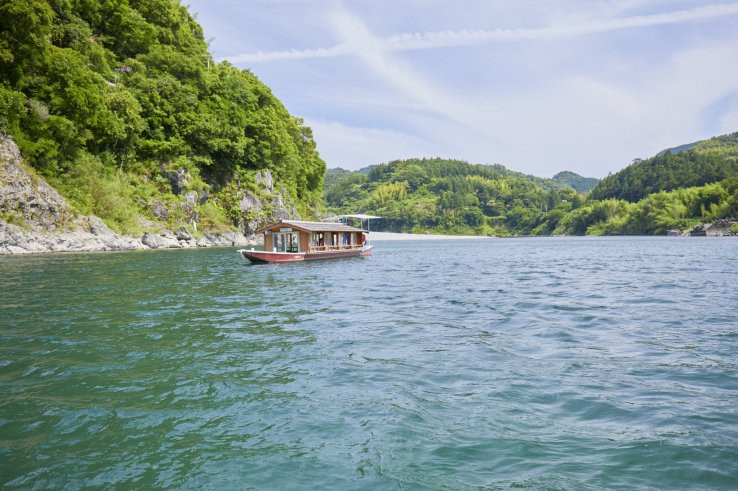 Known for the Niyodo Blue, a mysterious cobalt blue color born from the crystal clear streams, the water is transparent all the way to the riverbed below
Known for the Niyodo Blue, a mysterious cobalt blue color born from the crystal clear streams, the water is transparent all the way to the riverbed below
The Niyodo River, stretching 124 km, is one of Kochi’s defining natural landmarks, celebrated for its exceptional water quality and stunning blue hue. Known as “Niyodo Blue,” this mysterious cobalt blue color is born from the crystal-clear streams, making the water transparent to the riverbed below. According to the Ministry of Land, Infrastructure, Transport and Tourism, the Niyodo River consistently ranks as having the highest water quality in all of Japan, a testament to its pristine environment.
Visitors to the Niyodo River can engage in a variety of activities, from fishing and swimming to riding a river houseboat (yakatabune) with tatami mats and tables, perfect for enjoying lunch and listening to stories from a local guide as you float down the tranquil waterway. For those seeking a bit of adventure, soft rafting tours are available in the upper streams.
The Nakatsu Gorge, where the Nakatsu River flows into the Niyodo River, is a particularly popular spot for viewing Niyodo Blue. A scenic walking path weaves between large boulders and crosses the river with stone bridges, offering various perspectives of the mesmerizing waters. At the end of the path, you’ll be rewarded with a close-up view of the 20-meter “Ryudosui” waterfalls. The Niyodo River offers a serene escape into nature, where visitors can appreciate the unspoiled beauty of one of Japan’s cleanest rivers.
3.2.1. What Is Niyodo Blue?
Niyodo Blue is a unique cobalt blue color found in the Niyodo River, resulting from its crystal-clear streams and high water quality.
3.2.2. What Activities Can I Do on the Niyodo River?
You can enjoy fishing, swimming, river houseboat rides, and soft rafting tours. The Nakatsu Gorge also offers scenic walking paths.
3.3. Why Is the Shimanto River Called “Japan’s Last Remaining Unobstructed Stream”?
The Shimanto River is known as “Japan’s Last Remaining Unobstructed Stream” because it has no dams or blockages, preserving its natural state.
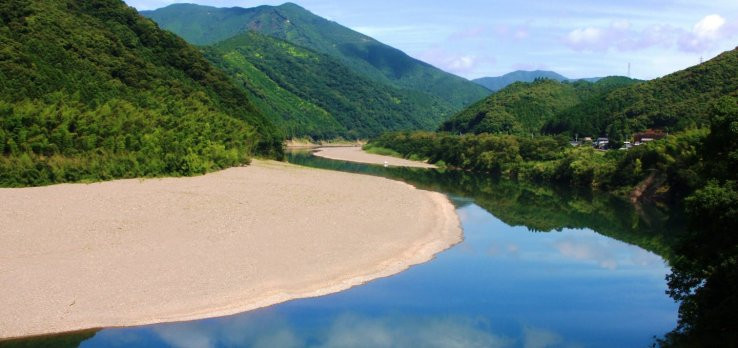 The Shimanto River is the longest river in Shikoku at 196 km and is known as “Japan’s last remaining unobstructed stream” with no dams or blockage throughout
The Shimanto River is the longest river in Shikoku at 196 km and is known as “Japan’s last remaining unobstructed stream” with no dams or blockage throughout
The Shimanto River, stretching 196 km, is the longest river in Shikoku and is celebrated as “Japan’s Last Remaining Unobstructed Stream” due to the absence of dams or blockages along its course. According to the Japan River Association, this unique feature preserves the river’s natural ecosystem and scenic beauty, making it a significant environmental and tourist attraction.
One of the most distinctive sights along the Shimanto River is the “Chinkabashi,” concrete bridges without railings designed to submerge during floods. These bridges are just wide enough for a single car and add to the river’s rustic charm. The Sada Chinkabashi, at 291.6 meters, is the longest and closest to the river’s mouth, drawing many tourists to witness this low-water crossing.
Exploring the Shimanto River is best done through the Shimanto Rin-Rin Cycle service, which offers bicycle rentals at seven terminals along the river. The flat terrain and minimal car traffic make cycling an accessible and enjoyable way to experience the river’s beauty. The Shimanto Tourist Information Center provides English support and materials to help visitors navigate the area. The Shimanto River offers a rare opportunity to connect with nature in its purest form, making it a must-visit destination for those seeking tranquility and natural beauty.
3.3.1. What Are Chinkabashi?
Chinkabashi are concrete bridges without railings designed to submerge during floods, a unique feature along the Shimanto River.
3.3.2. How Can I Explore the Shimanto River?
The best way to explore the river is through the Shimanto Rin-Rin Cycle service, which offers bicycle rentals at various terminals along the river.
3.4. Why Should I Visit Shikoku Karst Natural Park?
Shikoku Karst Natural Park is known as the roof of Shikoku, featuring a highland landscape with white limestone, cone-shaped sinkholes, and stunning views.
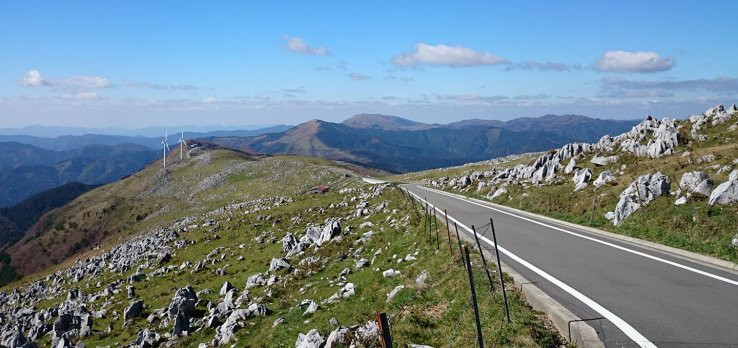 Known as the roof of Shikoku, the highland "Shikoku Karst" area is an elevated landform dotted with white limestone and cone-shaped sinkholes
Known as the roof of Shikoku, the highland "Shikoku Karst" area is an elevated landform dotted with white limestone and cone-shaped sinkholes
Shikoku Karst Natural Park, often referred to as the “Roof of Shikoku,” is a unique highland area characterized by its distinctive karst topography. This elevated landform features white limestone formations, cone-shaped sinkholes, and panoramic views that attract nature enthusiasts and photographers. According to the Japanese Ministry of the Environment, Shikoku Karst is one of the three major karst regions in Japan, making it a site of significant geological and ecological importance.
Visitors to Shikoku Karst can explore trails that wind through forested areas covered with Japanese cypress woodchips, providing a comforting and therapeutic experience. The nearby Tengu Kogen Highlands boasts the aptly named Forest Therapy Road, offering a gentle path through the woods.
Kochi is renowned in Japan for its exceptional stargazing opportunities, and Shikoku Karst National Park commands some of the best views of the night sky. The high altitude and minimal light pollution allow the stars to shine with remarkable clarity, making them appear close enough to touch. Whether you’re interested in hiking, nature photography, or stargazing, Shikoku Karst Natural Park offers a memorable experience in a unique and beautiful setting.
3.4.1. What Is Karst Topography?
Karst topography is a landscape characterized by limestone formations, sinkholes, and underground drainage systems, creating a unique and scenic environment.
3.4.2. What Activities Can I Do at Shikoku Karst Natural Park?
You can hike on trails covered with Japanese cypress woodchips, enjoy forest therapy on the Tengu Kogen Highlands, and stargaze at night.
3.5. What Makes Cape Ashizuri a Must-See Destination?
Cape Ashizuri offers sweeping ocean views, a historic lighthouse, and seaside hiking trails, making it a scenic and adventurous destination.
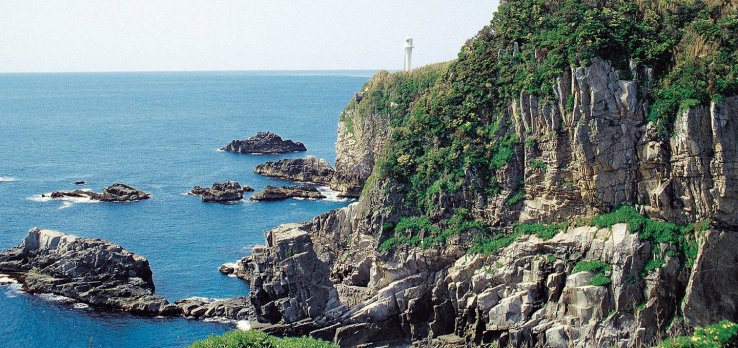 Cape Ashizuri is a promontory featuring an observation area with sweeping views of the ocean and the nearby lighthouse
Cape Ashizuri is a promontory featuring an observation area with sweeping views of the ocean and the nearby lighthouse
Cape Ashizuri, located at the tip of the Ashizuri Peninsula, is a promontory offering spectacular views of the Pacific Ocean and a rich array of natural and historical attractions. As the southernmost point of Shikoku, Cape Ashizuri is a bit remote, but its stunning scenery makes it a worthwhile destination for those exploring Kochi Prefecture. According to the Tosashimizu City Tourism Association, the cape is particularly known for its dramatic coastal landscapes and panoramic ocean views.
The cape features an observation area near the Ashizuri Lighthouse, which stands 18 meters tall and offers a breathtaking 270-degree view of the surrounding land and waters. The lighthouse itself is a historical landmark, having guided ships since its construction in the early 20th century.
Visitors can explore several trails in the area, including a two-kilometer seaside hiking trail that winds through the landscape overlooking the ocean. Glass-bottomed boat tours are available off the Tatsukushi and Minokoshi beaches near Cape Ashizuri, offering views of underwater scenes, such as coral and tropical fish. Cape Ashizuri is also a prime stargazing location, with minimal light pollution allowing for exceptional views of the night sky.
3.5.1. What Can I See at the Cape Ashizuri Lighthouse?
The Cape Ashizuri Lighthouse offers a breathtaking 270-degree panoramic view of the surrounding land and waters.
3.5.2. What Activities Are Available Near Cape Ashizuri?
You can enjoy seaside hiking trails, glass-bottomed boat tours to view coral and tropical fish, and stargazing at night.
4. What Is the Yosakoi Festival in Kochi?
The Yosakoi Festival is a vibrant dance festival held every summer in Kochi, featuring energetic performances, colorful costumes, and lively street festivities.
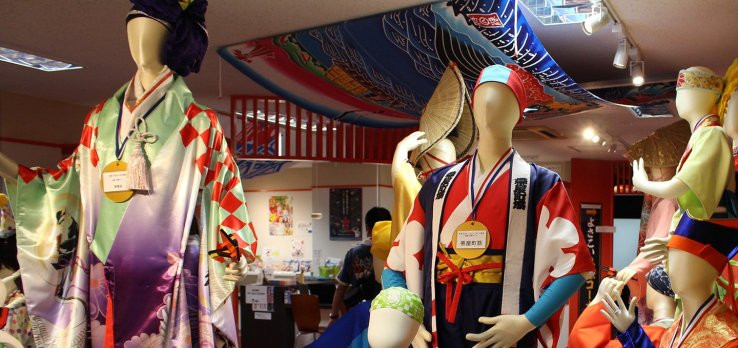 Sample the atmosphere of the Yosakoi Festival at the Kochi Yosakoi Information Exchange Center open year-round
Sample the atmosphere of the Yosakoi Festival at the Kochi Yosakoi Information Exchange Center open year-round
The Yosakoi Festival is an energetic and colorful dance festival deeply rooted in the culture of Kochi, celebrated annually from August 9th to 12th. This festival is one of Japan’s largest, attracting dance groups from across the country who come to showcase their vibrant costumes and dynamic performances. According to the Yosakoi Festival official website, the festival began in 1954 as a way to revitalize the city and has since grown into a national phenomenon.
Yosakoi dancers use “naruko” wooden clappers, adding a distinctive rhythm to the music and dance. The festival encourages audience participation, inviting visitors to join in the street festivities and move their hips to the infectious beat. The opening ceremonies include spectacular fireworks displays, adding to the festive atmosphere.
Even outside of the main festival dates, visitors can experience the spirit of Yosakoi at the Kochi Yosakoi Information Exchange Center, which is open year-round. Teams of Yosakoi dancers also perform in the city’s central arcade every Sunday from May to July and in front of JR Kochi Station every Sunday from August to December, providing ongoing opportunities to witness this exciting cultural tradition. The Yosakoi Festival embodies the energy and spirit of Kochi, making it a must-see event for anyone visiting the prefecture.
4.1. When Is the Yosakoi Festival Held?
The Yosakoi Festival is held every summer from August 9th to 12th.
4.2. What Are Naruko?
Naruko are wooden clappers used by Yosakoi dancers to create a distinctive rhythm during their performances.
5. How Can SIXT.VN Enhance My Trip to Kochi?
SIXT.VN offers convenient services such as airport transfers, hotel bookings, and curated tour packages, ensuring a smooth and enjoyable travel experience in Kochi.
Planning a trip to Kochi, Japan, can be an exciting but daunting task. SIXT.VN is here to simplify your travel arrangements and ensure a seamless and unforgettable experience. With a range of services tailored to meet the needs of international travelers, SIXT.VN can handle everything from airport transfers to hotel bookings and curated tour packages.
5.1. What Airport Transfer Options Does SIXT.VN Offer?
SIXT.VN provides reliable and comfortable airport transfer services, ensuring a smooth transition from the airport to your hotel in Kochi.
Arriving in a new country can be stressful, especially when navigating unfamiliar transportation systems. SIXT.VN offers convenient and reliable airport transfer services from Kochi Airport (KCZ) to your hotel or any other destination in Kochi City and beyond. According to customer testimonials, SIXT.VN’s professional drivers provide a comfortable and hassle-free experience, ensuring a smooth start to your trip. By pre-booking your airport transfer with SIXT.VN, you can avoid long taxi queues and the uncertainty of public transportation, allowing you to relax and focus on enjoying your trip.
5.2. How Can SIXT.VN Help Me Find the Perfect Hotel in Kochi?
SIXT.VN offers a wide selection of hotels to suit every budget and preference, ensuring you find the perfect accommodation for your stay in Kochi.
Finding the right accommodation is crucial for a comfortable and enjoyable trip. SIXT.VN offers an extensive selection of hotels in Kochi, ranging from budget-friendly options to luxurious resorts. Whether you’re looking for a hotel near Kochi Castle, a traditional Ryokan in the countryside, or a modern hotel with ocean views, SIXT.VN has you covered. The platform provides detailed descriptions, photos, and customer reviews to help you make an informed decision. By booking your hotel through SIXT.VN, you can take advantage of competitive rates and secure the perfect base for exploring Kochi.
5.3. What Kind of Tour Packages Does SIXT.VN Offer for Exploring Kochi?
SIXT.VN offers curated tour packages that cover the must-see attractions in Kochi, providing a comprehensive and enriching travel experience.
Exploring Kochi’s diverse attractions can be overwhelming without a well-planned itinerary. SIXT.VN offers curated tour packages designed to showcase the best of Kochi, from its historic landmarks to its stunning natural landscapes. These packages include guided tours of Kochi Castle, visits to the Sunday Market and Hirome Ichiba, excursions to the Niyodo and Shimanto Rivers, and trips to Cape Ashizuri and Shikoku Karst Natural Park. According to customer reviews, SIXT.VN’s tour guides are knowledgeable and passionate about Kochi, providing valuable insights and ensuring a memorable experience. Whether you’re interested in history, culture, nature, or food, SIXT.VN has a tour package to suit your interests.
6. What Are Some Travel Tips for Visiting Kochi?
Plan your visit during the Yosakoi Festival for a unique cultural experience. Rent a car to explore the countryside freely. Try local specialties like Katsuo no Tataki.
6.1. How Can I Experience the Yosakoi Festival?
Plan your visit around August 9th to 12th to witness the vibrant Yosakoi Festival. Join in the street festivities and enjoy the energetic performances.
6.2. What Is the Best Way to Explore the Countryside?
Renting a car or camper van is highly recommended for exploring the countryside freely. The roads are less congested, and it allows you to reach remote sightseeing spots.
6.3. What Are Some Local Specialties I Should Try?
Don’t miss trying Katsuo no Tataki (seared bonito tuna), Imokenpi (candied sweet potato sticks), and Botamochi (sweet rice balls). These are local delicacies that offer a taste of Kochi’s culinary culture.
7. What Are the Accommodation Options in Kochi?
Kochi offers a range of accommodations from traditional Ryokans to modern hotels, catering to different budgets and preferences.
7.1. What Are Ryokans?
Ryokans are traditional Japanese inns that offer a unique cultural experience. They often feature tatami mats, futon beds, and onsen (hot springs).
7.2. Where Can I Find Modern Hotels in Kochi?
Modern hotels are available in Kochi City, offering amenities such as Western-style rooms, restaurants, and convenient access to attractions.
8. What Is the Best Time to Visit Kochi?
The best time to visit Kochi is during the spring (March to May) or autumn (September to November) for pleasant weather and scenic views.
8.1. Why Visit Kochi in Spring?
Spring offers mild temperatures, blooming flowers, and pleasant conditions for outdoor activities.
8.2. What Can I Expect in Kochi During Autumn?
Autumn brings cooler temperatures, vibrant foliage, and comfortable weather for exploring the region’s natural beauty.
9. How Can I Get Around Kochi?
Kochi has a well-connected transportation system including buses, trains, and rental cars. The My Yu Bus is convenient for exploring Kochi City.
9.1. What Is the My Yu Bus?
The My Yu Bus is a tourist-friendly bus that connects major attractions in Kochi City, making it easy to explore the city’s highlights.
9.2. Where Can I Rent a Car in Kochi?
Rental cars are available at Kochi Airport and in Kochi City, offering flexibility for exploring the prefecture at your own pace.
10. What Are Some Hidden Gems in Kochi?
Explore the remote Iya Valley for stunning landscapes and traditional villages. Visit the Godaisan Observatory for panoramic views.
10.1. Why Visit Iya Valley?
Iya Valley offers breathtaking scenery, vine bridges, and a glimpse into traditional Japanese rural life.
10.2. What Can I See at the Godaisan Observatory?
The Godaisan Observatory provides panoramic views of Kochi City, the Pacific Ocean, and the surrounding mountains.
FAQ About Kochi Japan Tourism
Here are some frequently asked questions to help you plan your trip to Kochi, Japan:
Q1: Is Kochi worth visiting?
Yes, Kochi is definitely worth visiting for its stunning natural landscapes, rich culture, and delicious cuisine.
Q2: What is Kochi famous for?
Kochi is famous for its pristine rivers, long coastlines, Kochi Castle, the Yosakoi Festival, and local delicacies like Katsuo no Tataki.
Q3: What is the best time to visit Kochi?
The best time to visit Kochi is during the spring (March to May) or autumn (September to November) for pleasant weather and scenic views.
Q4: How do I get around Kochi?
You can get around Kochi by bus, train, rental car, or the My Yu Bus, which connects major attractions in Kochi City.
Q5: What are some must-try foods in Kochi?
Some must-try foods in Kochi include Katsuo no Tataki (seared bonito tuna), Imokenpi (candied sweet potato sticks), and Botamochi (sweet rice balls).
Q6: Where can I find traditional accommodations in Kochi?
Traditional accommodations, known as Ryokans, can be found throughout Kochi, offering a unique cultural experience.
Q7: What activities can I do in Kochi?
You can enjoy sightseeing, hiking, cycling, river activities, stargazing, and attending local festivals.
Q8: How can SIXT.VN help me plan my trip to Kochi?
SIXT.VN offers airport transfers, hotel bookings, and curated tour packages to ensure a smooth and enjoyable travel experience in Kochi.
Q9: What is the Yosakoi Festival?
The Yosakoi Festival is a vibrant dance festival held every summer in Kochi, featuring energetic performances, colorful costumes, and lively street festivities.
Q10: Are there any hidden gems to explore in Kochi?
Yes, you can explore the remote Iya Valley for stunning landscapes and traditional villages, or visit the Godaisan Observatory for panoramic views.
Ready to explore Kochi,



